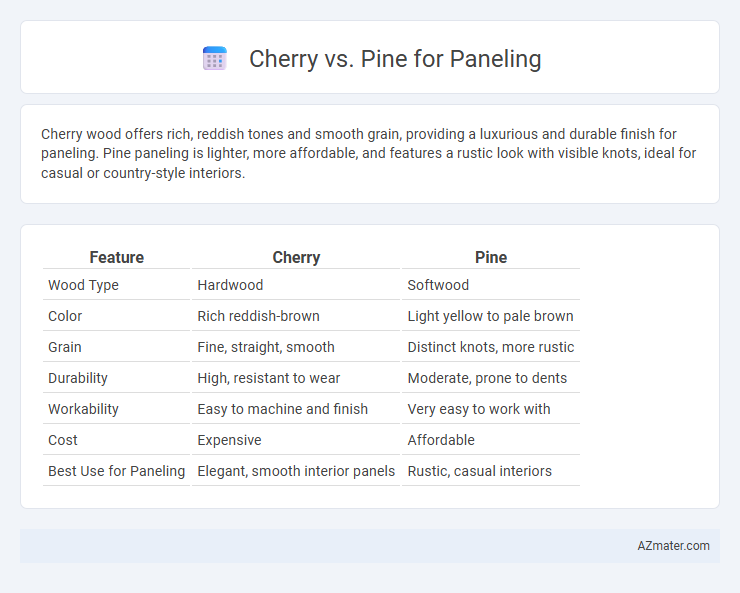Cherry wood offers rich, reddish tones and smooth grain, providing a luxurious and durable finish for paneling. Pine paneling is lighter, more affordable, and features a rustic look with visible knots, ideal for casual or country-style interiors.
Table of Comparison
| Feature | Cherry | Pine |
|---|---|---|
| Wood Type | Hardwood | Softwood |
| Color | Rich reddish-brown | Light yellow to pale brown |
| Grain | Fine, straight, smooth | Distinct knots, more rustic |
| Durability | High, resistant to wear | Moderate, prone to dents |
| Workability | Easy to machine and finish | Very easy to work with |
| Cost | Expensive | Affordable |
| Best Use for Paneling | Elegant, smooth interior panels | Rustic, casual interiors |
Overview of Cherry and Pine Wood
Cherry wood features a rich, warm reddish-brown hue that deepens with age, offering a smooth, fine grain ideal for elegant paneling. Pine, on the other hand, presents a lighter cream to pale yellow color with a more pronounced grain and occasional knots, lending a rustic and casual appearance to interiors. Both woods provide durability, but cherry is typically denser and harder than pine, making it a premium choice for sophisticated and long-lasting wall paneling.
Appearance and Grain Patterns
Cherry wood boasts a rich, reddish-brown hue that deepens over time, offering a warm and luxurious aesthetic ideal for elegant paneling. Its fine, straight grain with occasional subtle waves creates a smooth, uniform surface, enhancing the wood's sophisticated appearance. Pine features a lighter, pale yellow to amber color with prominent knots and a more pronounced, rustic grain pattern, making it suitable for casual or country-style paneling designs.
Durability and Hardness
Cherry wood, known for its fine grain and rich reddish hue, offers moderate durability and hardness with a Janka rating of approximately 950, making it suitable for decorative paneling in low to medium-traffic areas. Pine, softer with a Janka rating around 420, is less durable and prone to dents and scratches, but its lighter color and rustic appeal make it popular for casual or country-style interiors. For paneling requiring greater resistance to wear and damage, cherry provides a harder, more resilient surface compared to pine, which may require more frequent maintenance.
Workability and Installation
Cherry wood offers excellent workability due to its fine, straight grain and uniform texture, allowing for smooth cutting, sanding, and shaping during paneling installation. Pine is softer and lighter, making it easier to handle and install, though it may dent or scratch more easily than cherry. Both woods require pre-drilling for fasteners, but cherry's hardness provides a more secure hold for nails and screws, enhancing long-term panel stability.
Cost Comparison
Cherry paneling typically costs between $8 to $15 per square foot, reflecting its premium quality and rich, warm tones. Pine paneling is more budget-friendly, ranging from $3 to $7 per square foot, making it a popular choice for cost-conscious projects. The price difference is influenced by cherry's durability and aesthetic appeal, whereas pine offers affordability and ease of installation.
Maintenance and Longevity
Cherry wood paneling offers moderate maintenance with natural resistance to decay and a rich patina that enhances over time, making it durable yet sensitive to scratches and direct sunlight. Pine paneling requires more frequent upkeep due to its softer nature, making it prone to dents and scratches, but it is easy to repair and refinish, extending its lifespan with consistent care. Both options provide longevity, but cherry's density and aging qualities generally result in a longer-lasting and more resilient surface compared to pine.
Environmental Impact and Sustainability
Cherry wood paneling is known for its slower growth rate, which makes its harvesting less sustainable compared to pine, a fast-growing softwood with a quicker renewal cycle. Pine is often sourced from managed forests that prioritize reforestation and lower carbon footprints, making it a more environmentally friendly option. While cherry offers durability and rich aesthetics, pine's renewable nature and lower environmental impact make it preferable for sustainable paneling choices.
Ideal Applications for Paneling
Cherry wood, prized for its rich, warm reddish-brown hue and fine grain, is ideal for elegant interior paneling in formal living rooms, libraries, and upscale offices where a luxurious aesthetic is desired. Pine, characterized by its lighter color, knotty texture, and affordability, suits casual settings such as cabins, rustic kitchens, and children's rooms, providing a cozy and natural ambiance. Both woods offer durability for wall paneling, but cherry's refined appearance makes it preferred for high-end applications while pine thrives in relaxed, budget-conscious environments.
Design Versatility and Finishing Options
Cherry wood offers rich, warm tones that deepen over time, making it ideal for creating sophisticated and classic paneling designs. Pine provides a lighter, more neutral base that adapts well to various stains, paints, and finishes, enhancing its versatility for both rustic and contemporary interiors. Cherry's smooth grain lends itself to fine detailing and polished finishes, while pine's softer texture allows for distressed or matte effects, broadening design possibilities.
Choosing Between Cherry and Pine for Your Project
Cherry wood offers a rich, warm hue with a smooth grain that deepens over time, making it ideal for elegant, long-lasting paneling projects that benefit from a luxurious appearance. Pine is a softer, more affordable option characterized by a lighter tone and prominent knots, suitable for rustic or casual designs where budget and ease of staining are priorities. Selecting between cherry and pine depends on the desired aesthetic, durability requirements, and budget constraints of your paneling project.

Infographic: Cherry vs Pine for Paneling
 azmater.com
azmater.com